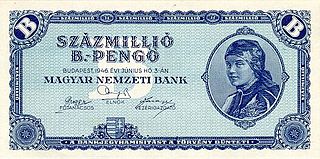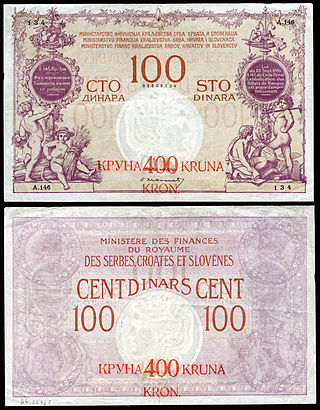
The krona is the official currency of the Kingdom of Sweden. Both the ISO code "SEK" and currency sign "kr" are in common use; the former precedes or follows the value, the latter usually follows it but, especially in the past, it sometimes preceded the value. In English, the currency is sometimes referred to as the Swedish crown, as krona means "crown" in Swedish. The Swedish krona was the ninth-most traded currency in the world by value in April 2016.

The schilling was the currency of Austria from 1925 to 1938 and from 1945 to 1999, and the circulating currency until 2002. The euro was introduced at a fixed parity of €1 = 13.7603 schilling to replace it. The schilling was divided into 100 groschen.

The svenska riksdaler was the name of a Swedish coin first minted in 1604. Between 1777 and 1873, it was the currency of Sweden. The daler, like the dollar, was named after the German Thaler. The similarly named Reichsthaler, rijksdaalder, and rigsdaler were used in Germany and Austria-Hungary, the Netherlands, and Denmark-Norway, respectively. Riksdaler is still used as a colloquial term for Sweden's modern-day currency.

The forint is the currency of Hungary. It was formerly divided into 100 fillér, but fillér coins are no longer in circulation. The introduction of the forint on 1 August 1946 was a crucial step in the post-World War II stabilisation of the Hungarian economy, and the currency remained relatively stable until the 1980s. Transition to a market economy in the early 1990s adversely affected the value of the forint; inflation peaked at 35% in 1991. Between 2001 and 2022, inflation was in single digits, and the forint has been declared fully convertible. In May 2022, inflation reached 10.7% amid the war in Ukraine and economic uncertainty. As a member of the European Union, the long-term aim of the Hungarian government may be to replace the forint with the euro, although under the current government there is no target date for adopting the euro.

The krone is the official currency of Denmark, Greenland, and the Faroe Islands, introduced on 1 January 1875. Both the ISO code "DKK" and currency sign "kr." are in common use; the former precedes the value, the latter in some contexts follows it. The currency is sometimes referred to as the Danish crown in English, since krone literally means crown. Historically, krone coins have been minted in Denmark since the 17th century.

The crown was the official currency of Austria-Hungary from 1892 until the dissolution of the empire in 1918. The subunit was one hundredth of the main unit, and was called a heller in German and a fillér in Hungarian.

The pengő was the currency of Hungary between 1 January 1927, when it replaced the korona, and 31 July 1946, when it was replaced by the forint. The pengő was subdivided into 100 fillér. Although the introduction of the pengő was part of a post-World War I stabilisation program, the currency survived for only 20 years and experienced the most serious case of hyperinflation ever recorded.

The Czechoslovak koruna was the currency of Czechoslovakia from 10 April 1919 to 14 March 1939, and from 1 November 1945 to 7 February 1993. For a brief time in 1939 and again in 1993, it was also the currency in the separate Czech Republic and Slovakia.

The rigsdaler was the name of several currencies used in Denmark until 1875. The similarly named Reichsthaler, riksdaler and rijksdaalder were used in Germany and Austria-Hungary, Sweden and the Netherlands, respectively. These currencies were often anglicized as rix-dollar or rixdollar.

The perper was the currency of Montenegro between 1906 and 1918. It was named the same as the medieval Serbian Empire official currency, and it was divided into 100 para.

The florin was the currency of the lands of the House of Habsburg between 1754 and 1892, when it was replaced by the Austro-Hungarian crown as part of the introduction of the gold standard. In Austria, the florin was initially divided into 60 kreutzers. The currency was decimalized in 1857, using the same names for the unit and subunit.

The Liechtenstein krone was the currency of Liechtenstein from 1898 to 1921. The coins are rare, although the banknotes are somewhat more common. The krone was divided into 100 heller. Liechtenstein used the Austro-Hungarian krone and Austrian krone after the dissolution of the Austro-Hungarian Empire in 1918, and then switched to the Swiss franc in 1921 due to krone's instability. The Liechtenstein krone had the same amount of precious metal as the Austro-Hungarian krone or the Austrian krone. Coins came in values of 1, 2, 5, 10, 20 kronen. In 1920, small-change notes denominated in 10, 20, and 50 heller were issued as an emergency measure to supplement the coins then available.

The krone was a short-lived, provisional currency used in parts of the then newly formed Kingdom of Serbs, Croats, and Slovenes, parts of which had previously been part of the Austro-Hungarian Empire (Austria-Hungary). It was worth 1⁄4 of a dinar or 25 para. The name translates into English as crown.

The Hungarian korona was the replacement currency of the Austro-Hungarian Krone/korona amongst the boundaries of the newly created post-World War I Hungary. It suffered a serious inflation and was replaced by the pengő on 1 January 1927.
The paper money of the Hungarian korona was part of the circulating currency in the post-World War I Kingdom of Hungary until the introduction of the pengő in 1927. The variety of the banknotes and treasury notes and the variety of issuing authorities reflect the chaotic postwar situation in the country.

The Krone was the currency of Austria and Liechtenstein after the dissolution of the Austro-Hungarian Empire (1919) until the introduction of the Austrian schilling (1925), and, in Liechtenstein, the Swiss franc.
The banknotes of the Yugoslav dinar were several series of paper money printed by the central bank of the different consecutive states named Yugoslavia.
This is a description of the current and historical currencies of Croatia, or historically used in the region. The currency of Croatia is the euro, in use since 2023.

The Austro-Hungarian Bank was the central bank of the Habsburg Monarchy in the 19th and early 20th centuries.















































